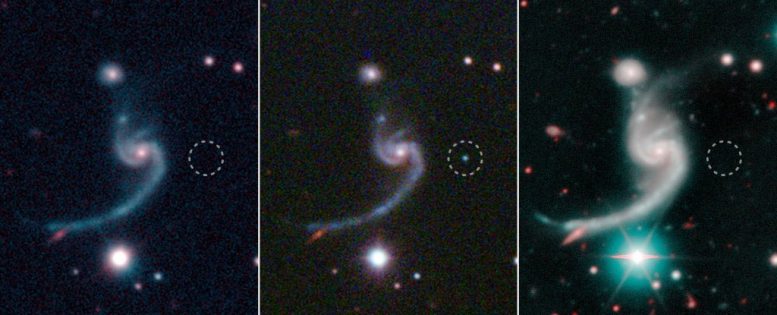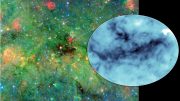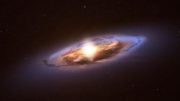
The three panels represent moments before, during, and after the faint supernova iPTF14gqr, visible in the middle panel, appeared in the outskirts of a spiral galaxy located 920 million light years away. The massive star that died in the supernova left behind a neutron star in a very tight binary system. These dense stellar remnants will ultimately spiral into each other and merge in a spectacular explosion, giving off gravitational and electromagnetic waves. Credit: SDSS/Caltech/Keck
A Caltech-led team of researchers has observed the peculiar death of a massive star that exploded in a surprisingly faint and rapidly fading supernova. These observations suggest that the star has an unseen companion, gravitationally siphoning away the star’s mass to leave behind a stripped star that exploded in a quick supernova. The explosion is believed to have resulted in a dead neutron star orbiting around its dense and compact companion, suggesting that, for the first time, scientists have witnessed the birth of a compact neutron star binary system.
The research was led by graduate student Kishalay De and is described in a paper appearing in the October 12 issue of the journal Science. The work was done primarily in the laboratory of Mansi Kasliwal (MS ’07, Ph.D. ’11), assistant professor of astronomy. Kasliwal is the principal investigator of the Caltech-led Global Relay of Observatories Watching Transients Happen (GROWTH) project.
When a massive star—at least eight times the mass of the sun—runs out of fuel to burn in its core, the core collapses inwards upon itself and then rebounds outward in a powerful explosion called a supernova. After the explosion, all of the star’s outer layers have been blasted away, leaving behind a dense neutron star—about the size of a small city but containing more mass than the sun. A teaspoon of a neutron star would weigh as much as a mountain.
During a supernova, the dying star blasts away all of the material in its outer layers. Usually, this is a few times the mass of the sun. However, the event that Kasliwal and her colleagues observed, dubbed iPTF 14gqr, ejected matter only one-fifth of the mass of the sun.
“We saw this massive star’s core collapse, but we saw remarkably little mass ejected,” Kasliwal says. “We call this an ultra-stripped envelope supernova and it has long been predicted that they exist. This is the first time we have convincingly seen core collapse of a massive star that is so devoid of matter.”
The fact that the star exploded at all implies that it must have previously been enveloped in lots of material, or its core would never have become heavy enough to collapse. But where, then, was the missing mass?
The researchers inferred that the mass must have been stolen—the star must have some kind of dense, compact companion, either a white dwarf, neutron star, or black hole—close enough to gravitationally siphon away its mass before it exploded. The neutron star that was left behind from the supernova must have then been born into orbit with that dense companion. Observing iPTF 14gqr was actually observing the birth of a compact neutron star binary. Because this new neutron star and its companion are so close together, they will eventually merge in a collision similar to the 2017 event that produced both gravitational waves and electromagnetic waves.
Not only is iPTF 14gqr a notable event, the fact that it was observed at all was fortuitous since these phenomena are both rare and short-lived. Indeed, it was only through the observations of the supernova’s early phases that the researchers could deduce the explosion’s origins as a massive star.
“You need fast transient surveys and a well-coordinated network of astronomers worldwide to really capture the early phase of a supernova,” says De. “Without data in its infancy, we could not have concluded that the explosion must have originated in the collapsing core of a massive star with an envelope about 500 times the radius of the sun.”
The event was first seen at Palomar Observatory as part of the intermediate Palomar Transient Factory (iPTF), a nightly survey of the sky to look for transient, or short-lived, cosmic events like supernovae. Because the iPTF survey keeps such a close eye on the sky, iPTF 14gqr was observed in the very first hours after it had exploded. As the earth rotated and the Palomar telescope moved out of range, astronomers around the world collaborated to monitor iPTF 14gqr, continuously observing its evolution with a number of telescopes that today form the GROWTH network of observatories.
The Zwicky Transient Facility, the successor of iPTF at Palomar Observatory, is examining the sky even more broadly and frequently in the hopes of catching more of these rare events, which make up only one percent of all observed explosions. Such surveys, in partnership with coordinated follow-up networks like GROWTH, will enable astronomers to better understand how compact binary systems evolve from binary massive stars.
The research was primarily funded by the National Science Foundation under the PIRE GROWTH project. A full list of funding sources and co-authors can be found in the Science study, titled “A hot and fast ultra-stripped supernova that likely formed a compact neutron star binary.” In addition to De and Kasliwal, other Caltech co-authors are Gary Doran of the Jet Propulsion Laboratory; graduate student Gina Duggan; Shri Kulkarni, George Ellery Hale Professor of Astronomy and Planetary Science; and Russ Laher and Frank Masci of Caltech’s Infrared Processing and Analysis Center.
Reference: “A hot and fast ultra-stripped supernova that likely formed a compact neutron star binary” by K. De, M. M. Kasliwal, E. O. Ofek, T. J. Moriya, J. Burke, Y. Cao, S. B. Cenko, G. B. Doran, G. E. Duggan, R. P. Fender, C. Fransson, A. Gal-Yam, A. Horesh, S. R. Kulkarni, R. R. Laher, R. Lunnan, I. Manulis, F. Masci, P. A. Mazzali, P. E. Nugent, D. A. Perley, T. Petrushevska, A. L. Piro, C. Rumsey, J. Sollerman, M. Sullivan and F. Taddia, 12 Oct 2018, Science.
DOI: 10.1126/science.aas869









Be the first to comment on "Astronomers Observe a Surprisingly Faint and Rapidly Fading Supernova"